Random
Shots
- To the Arno -
Armored Training | Eboli to Rome | To the Arno | Northern ApenninesPo Valley | Vicenza Combat | Post-War | At Ease
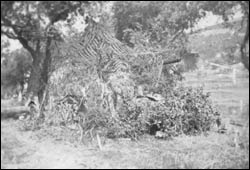 |
An extremely well camouflaged Sherman of the 752nd, on a roadblock assignment north of Rome during the summer of 1944. The 75mm main gun is poking out of the camouflage netting and is pointing to the right of the photo. |
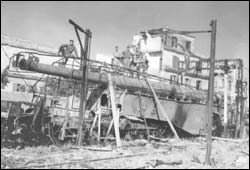 |
752nd tankers stand on top of the famous German railway gun "Anzio Annie." Known by the Germans as "Leopold," this 280mm K5 gun could lob its 563 lb. shell 31 miles, and caused much loss of life and equipment on Anzio beach. Leopold was captured by the 168th Regiment of the 34th Infantry Division on 7 June 1944 at Civitavecchia, north of Rome. Leopold now resides at Aberdeen Proving Grounds in Maryland. |
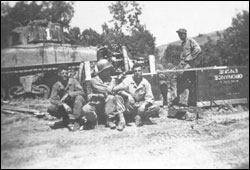 |
Between 24 June and 28 June 1944, the 752nd engaged in heavy maintenance work. All tracks were changed from steel to rubber block, and 14 engines were replaced. Here, the engine on Tank #1 of B Company has been uncrated and is being readied for installation. |
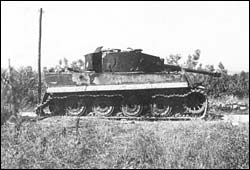 |
Tiger 221 of the 504th sPzAbt was knocked out by Tank #11, 3rd Platoon of B Company in Cecina on 1 July 1944. A direct shot to the lower front hull at 75 yards failed to stop this Tiger. Minutes later, a 75mm AP round into the fuel tank from 25 yards brought Tiger 221 to a halt. Lt. Edwin Cox was awarded the Silver Star for this action. Click here for the detailed story. |
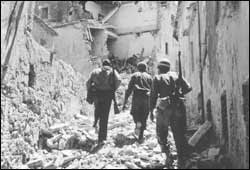 |
The battle for Rosignano (3-12 July 1944) was extremely difficult for the 752nd. The hilly and narrow streets were filled with rubble, dead, and wounded, and provided excellent defensive positions for snipers. Shown here is a street in Rosignano Marritimo near the end of the battle. (Official U.S. Signal Corps photo). |
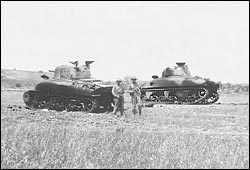 |
These tanks were originally thought to be two B Company 3rd Platoon tanks that were destroyed on the outskirts of Rome. However, newly discovered civilian photos and a study of map coordinates and terrain features reveal that these 752nd tanks that were lost at Rosignano on 12 July 1944. All four tanks lost at Rosignano were hit by German 88s from two Tiger tanks of the German sPzAbt 504. Both of the tanks shown here burned, as Shermans were prone to do when hit. |
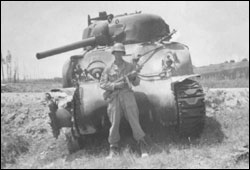 |
Another B Company tank destroyed near Rosignano on 12 July 1944. The tank was disabled by an 88mm shell which blew off the right track. This tank did not burn. |
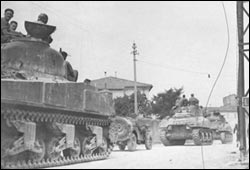 |
752nd tanks entering Livorno (Leghorn) from the east on 19 July 1944. The 752nd operated a mix of M4 and M4A1 Sherman tanks during 1944, as seen in this photo. The M4 in the foreground is Registration #3010824, which was built by Baldwin Locomotive. Notice the applique armor on the M4, which is seldom seen in 752nd photos. This tank also incorporated the old direct vision slots for the drivers. The house in the background still exists today, but the steel tower and Livorno sign were removed when an underground pedestrian crossing was constructed long after the war. (Official U.S. Signal Corps photo). |
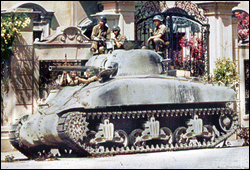 |
A rare color photo of an early production M4A1 of B Company's 3rd Platoon guarding a roadblock in Livorno, most likely taken on 22 July 1944, several days after Livorno was secured. This is a shot that was staged by the photographer for the enjoyment of the folks back home. Originally labeled as simply "on the road to Pisa." Some historians and enthusiasts once believed this was taken in Ponsacco, but the 752 was nowhere near Ponsacco. It is now confirmed that the location is in front of the Villa Bertocchini in downtown Livorno. The once beautiful Villa Bertocchini survived the war, only to be torn down and replaced with an ugly apartment complex. This tank belonged to my dad, who is show in the tank commander's position manning the .50 machine gun. (Official U.S. Signal Corps photo). |
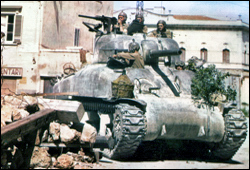 |
Another M4A1
of B Company's 3rd Platoon in Livorno, this one a mid-production M4A1.
This is another staged action shot in the 22 July series of at
least 4 colored photos (the other two photos have not yet surfaced).
The rubble on the left side was placed there to designate the beginning
of the "Zona Nera" (Black Zone), a heavily mined industrial
district that civilians were forbidden to enter. The
location
is one block away from the photo above, and Villa Bertocchini is the
light colored building in the background. Bothphotos
have been incorrectly labeled as 1st Armored Division
tanks in various
books and websites. However, the original photo caption in the National
Archives,
the markings on the tank, the historical facts, and the
unmistakable identities of the 752nd
men clearly indicate this is a 752nd tank. (Official
U.S. Signal Corps
photo). |
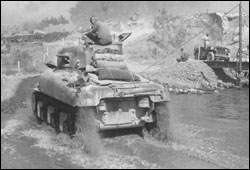 |
A tank of the 752nd crosses the Sieve River near San Piero on 13 September 1944, in preparation for the attack on the Gothic Line. Off in the distance, a smoke screen has been set up to obscure the movement of the tanks and troops. (Official U.S. Signal Corps photo). |
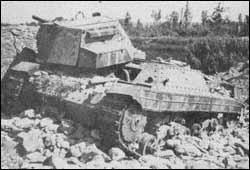 |
The 752nd unit history calls this a German Mark IV, but it is actually a very rare Carro Armato P40 heavy tank. The Italian-designed prototype was captured by the Germans, who then manufactured 101 units. Forty of them were built with no engines and were used as pillboxes. This particular vehicle probably had no engine, given its defilade position. The 752nd history says this P40 was destroyed in the summer of 1944 near Siena, but that location is highly questionable. |
Back to Top of Page
Researched
and Written by Robert J. Holt
Page Content Copyright 2003 - 2025 Robert J. Holt
All Rights Reserved